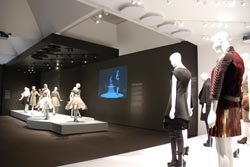- Boston's Museum of Fine Arts used Holosonic's Audio Spotlight directional sound system to incorporate "runway" music into its "Fashion Show: Paris Collections" exhibit without intruding on the peaceful museum ambiance. Each of 10 designers' collections featured a unique soundscape which was pinpointed from above the exhibits directly to nearby viewers, preventing audio overlap.?Where digital signage, video projection, and control technology were once employed by only the most cutting-edge of museums, today they are becoming standard fare among both new facilities and existing venues.
- Jim Walker, systems designer at MediaMerge in Chelsea, AL, notes that aside from the desirable 'wow' factor, these facilities employ these systems to answer what has become the expectation: the public is accustomed to seeing AV pretty much everywhere, including museum exhibits. "A lot of it is the desire to stay relevant and exciting to people," he said. "A lot of museums are integrating AV equipment into their exhibits to keep up."
- From an audio perspective, Russell Todd, principal at the South Norwalk, CT-based acoustic consultancy Akustiks, notes that as more and more AV systems are integrated at the exhibit level, overkill must be taken into account. "This creates a situation where you really need to address the acoustics so that, with all of this audio, you don't have bleed and disruption between exhibits," he said. "We are finding that the exhibit designers are recognizing that you can't let the technology, or the interaction of the technology and the acoustics interfere with the communication of the story or the idea." Instead, the technology needs to support the exhibit, rather than get in the way of it.
- A significant benefit is that once these systems are in place, updating exhibit content becomes much more streamlined. "The hardware costs money, but it's something that the software can change with relative ease," Walker said. "One of the big issues in museums is to be able to change what they are doing and to have new content to get people who have been there once to come back." Features such as Imax theaters serve to generate repeat business, he cites. "Not only are they a way of presenting the content, but to get people back down there. If you change your content six times a year, hopefully they will come back six times."
- Today, Walker is fielding an increasing number of requests for information on digital cinema. "It's the whole idea of having something that is renewable, and digital cinema seems like the way to do that," he said. "A digital cinema venue would be useful for a variety of things-not just presenting content, but it could also be used as a rental space."
For the McWane Science Center in Birmingham, AB, MediaMerge brought the "Sea Monsters of Alabama" to life with video playback and multi-channel sound generated by a media server. MediaMerge also implemented a moving underwater lighting effect on the walls and fossils, and even used video projection for the exhibits' informational placards, which themselves were LED-lit, engraved glass plates. Users can access the video information by pressing a series of buttons built into the countertops.
Large-scale control is also in demand, as museum technicians seek more efficient ways of monitoring and operating their exhibits. "AV has been in museums for a long time, but it frequently involves a lot of people with remote controls going around and turning things on and off each day, and not a lot of centralized control," Walker said. "Now that it is widely available, and the operators in these situations have seen it, they would like it as well."
Jon Burris, partner at the consulting firm Shen Milsom and Wilke in New York, NY, notes that the needs differ from art museums and what he dubs cultural, or science museums. "The art museums, from our perspective-and I wouldn't say it's purely audiovisual-require a very robust Information Technology infrastructure, particularly in permanent and temporary galleries," he noted. These systems are used for search functions, security, signage, and building management control in addition to features relating to the visitor's experience, such as tour guide systems.
"Art museums in general are hesitant to make technological enhancements within the gallery itself; they tend to be separate or adjacent to the galleries rather than within them. I think that's because there is a certain relationship to the artwork that's in there." Science museums focus more on incorporating technology into the actual exhibits. "They really do want to be able to have an experience that extends the artifacts," Burris said.
Walker, who worked in several museums before taking his post at MediaMerge, points out that systems integrators serving this market must familiarize themselves with the way museums conduct their decision-making process, and how they are funded. The retail marketplace, he illustrates, has embraced digital signage a little faster-in part because retailers can charge for advertising that they put up on the displays. "A museum is certainly going to use it to advertise what's going on, but they are not going to sell outside advertising," he said. "For most AV projects in museums, they spend a lot of time thinking about it, and then fairly quickly they move from, 'We'd like to do this,' to 'We've got a big bundle of money and we need to do this quickly.'"
The timeframes are different, because these facilities must first raise money from their sponsors, and then put it to use quite quickly after funding is received. Many museums are owned by government organizations at the city or state level, or through non-profits that are attached to the city. In these cases, certain administration procedures must be adhered to when carrying a project out.











